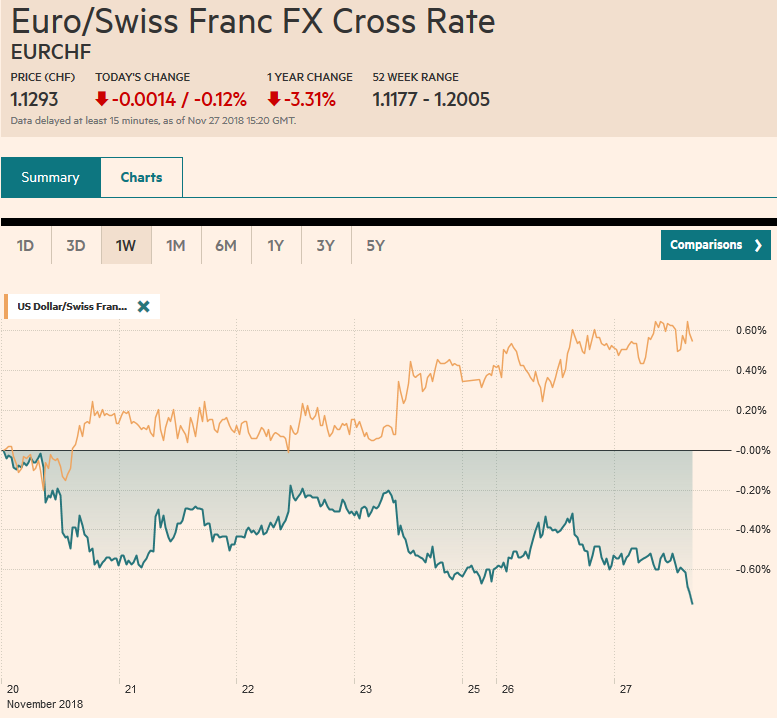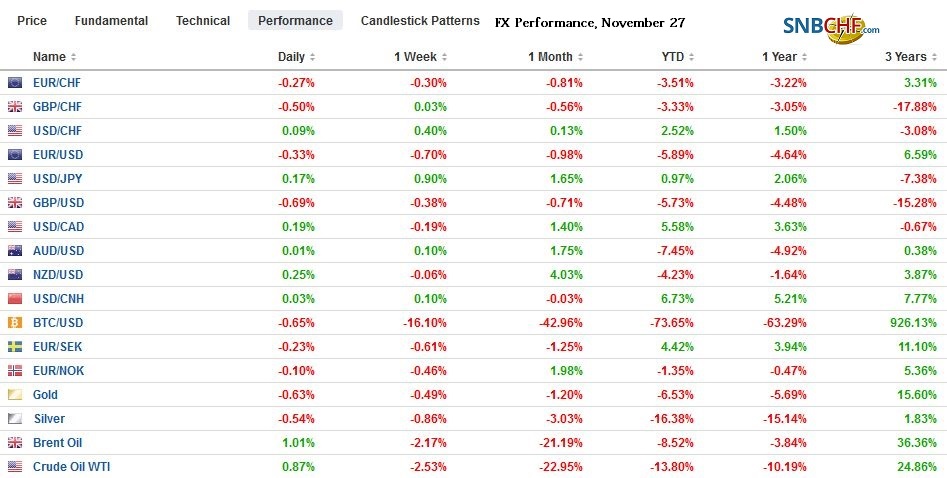Swiss FrancThe Euro has fallen by 0.12% at 1.1293 |
EUR/CHF and USD/CHF, November 27(see more posts on EUR/CHF, USD/CHF, ) Source: markets.ft.com - Click to enlarge |
FX RatesOverview: The global capital markets have taken the US latest tariff threats in stride. Most of the Asian equity markets advanced, including Japan, Korea, Taiwan, India, and Australia. China and Hong Kong were exceptions with marginal losses. European markets are trying to extend their recovery for a third session, but the industry performance is mixed with energy and materials lower, and utilities, consumer staples, and information technology / communication advancing. Benchmark 10-year yields are one-two basis points lower. Oil is paring yesterday’s gains, while weakness continues to be seen in the industrial metals complex. The US dollar is mixed. The Antipodean and Scandis are firmer, while the euro, sterling, and yen have slipped. |
FX Performance, November 27 |
North America
General Motors decision to lay off 14,000 workers, close three plants, and end the production of the Volt may not have much effect the nearly $20 trillion national economy but it will be a blow to families, towns, and cities and ancillary businesses. On the national level, its significance outstrips the direct economic impact. It is not as if the tariffs are the only source of pressure on automakers, but they certainly do not help. The steel and aluminum tariffs favor producers. GM and other automakers are consumers of metals. They have cautioned against the tariffs and are opposed to the auto tariffs the President continues to threaten. Using a 12-month moving average, auto sales peaked in early 2016, According to reports, in the first nine months of this year, GM sold 2.7 mln vehicles in China and 2.2 mln vehicles in the US. GM’s success in penetrating the Chinese market is not going to show up much in trade figures but until the modern revisionists, locally produced and locally sold goods were understood as an important part of the US commercial expansion, soft power, and development strategy. GM’s decision offers a prima face case that American industry also may have excess capacity, which raises questions about the likelihood of success in re-shoring the global supply chains.
Trump toys with investors. After playing up the possibility of a deal with President Xi this weekend, he told the Wall Street Journal that he expects to go forward with the plan to increase the tariff on $200 bln of Chinese goods to 25% from 10%. Chinese officials have reportedly signaled that preventing that tariff increase was their primary objective. At the same time, Trump reiterated his threat to levy a 10% or 25% tariff on the remained $267 bln of goods the US imports from China. This would include consumer electronic goods too. Trump recognized that a 25% tariff would be a big blow to US consumers, but he seemed to suggest that people can cope with a 10% tariff. US shares weakened in after-hours trading after the report was published.
The US reports on house prices and consumer confidence today will be overshadowed by the beginning of the flurry of Fed speakers over the next few days. While all Fed officials have their own opinions, some are more impactful than others. The Federal Reserve Board Vice President Clarida speaks in NY before the equity market opens. He has endorsed the continued gradual increase of rates to neutrality. Later in the session, regional Presidents, Bostic, Evans, and George are on a panel discussion. Although Bostic is among the most dovish members, he and George are voting members of the FOMC, and both supported the September hike. Bostic has argued for a pause and therefore may dissent from a decision to hike next month. Powell speaks tomorrow at lunch in NYC. The Fed’s leadership-Powell, Clarida, and Williams–and are showing a united front.
In addition to the weekly four- and eight-week bill auctions the US auctions $40 bln five-year notes today. This may be the sweet part of the curve. The shorter maturities are weighed by prospects of Fed tightening, while the 10-year may be too risky, given the debt profile. The five-year may also be tenor that attracts foreign central banks. After the markets close, API will provide its estimate of oil inventories. The EIA will report its estimate tomorrow. It could be the first decline in nine weeks.
The S&P 500 gapped higher yesterday and closed on its highs. It entered a gap that had been created by last Wednesday’s lower opening. The gap extends to last Tuesday’s high near 2681.10. A close above here would lift the technical tone and could set the stage of a run at 2761 where the 200-day moving average is found. Recall that before the weekend the S&P 500 gapped lower too and yesterday’s gap higher, make Friday’s price action a bullish one-day island. Yesterday’s gap is found roughly between 2647.5 and 2650.
Asia-Pacific
New Zealand reported a larger than expected October merchandise trade deficit of NZ$1.295 bln. The increase in exports was a little less than expected, while the rise in imports was a bit more than expected. The 12-month rolling deficit widened to NZ$5.79 bln from NZ$5.33 bln, which is the largest in at least a decade. The New Zealand dollar extended yesterday’s losses marginally and then recovered in Asia and through the European morning to retest $0.6800. The New Zealand dollar has not risen above the previous session’s high since November 16 when it reached almost $0.6885. Yesterday’s high was near $0.6815. For its part, the Australian dollar is confined to yesterday’s range and continues to consolidate between $0.7200 and $0.7300 as it has done for over a week. That said, it is holding up well in the face of the sharp drop in iron ore prices and weakness Chinese equities, both of which many observers link to the Australian dollar.
The dollar is steady against the Japanese yen near yesterday’s highs around JPY113.50. There are two sets of expiring options that are of note today. There is a $450 mln option at JPY113.45 and $485 mln at JPY113.10. The intraday technical readings are stretched, suggesting resistance near JPY113.70 may remain intact.
Europe
ECB’s Draghi used his testimony before the European Parliament to reiterate the central bank’s stance. Despite the slowdown that is more than expected and the prognosis for falling inflation in the coming months, the new asset purchases will cease at the end of next month. Draghi continues to cite domestic demand and wage growth to lift prices. This suggests that the ECB may retain a balanced risk assessment at next month’s meeting. A change toward recognizing downside risks would be seen as dovish. At the same time, Draghi recognizes that extraordinary monetary policy is still required and all the other policies but the asset purchases are set to continue to some time. It is possible that the ECB provides another Targeted Long-Term Repo Operation (TLTRO), which may be deemed necessary before a rate hike can be delivered.
With the changes in the German auto sector, of course, Draghi is likely correct that some of the slowdown in the EMU is temporary, but there is something more sinister likely taking place. The ECB introduced a negative deposit rate in June 2014 and began buying government bonds nine months later. And yet even yesterday, Draghi is beseeching countries to adopt structural reforms that will boost the growth potential. Many economists look at a country like Italy with high levels of unemployment as argue that Italy cannot possibly be operating at capacity. However, if structural obstacles exist that prevent people from securing jobs or freeing up capital from non-profitable businesses or rules that favor rent seekers then assessing capacity requires more than simply looking at unused factors of production.
As we noted yesterday, one way the Italian government can show a smaller deficit without backtracking on its campaign promises is to delay the start of some new initiatives, like the Citizen’s Income. Also, who can qualify for the rolling back of pension reforms could also be tightened on the margins. This may save a couple tenths of a percent and some press reports suggest that Italy may be headed in this direction. However, the EC is expected to push back still. It wants the deficit to be no more than 2% of GDP, and the government’s forecast is based on optimistic projections of growth. Separately, note that the European Court of Human Rights is set to rule on whether Berlusconi can run for office again. If he can, the thinking is that later next year, perhaps after the spring election for the European Parliament, League leader Salvini will precipitate a political crisis and team up with a more natural and traditional ally, Berlusconi for a center-right government.
The euro reached almost $1.1475 last week. Today it successfully tested $1.1300 support. The narrowing of the Italian premium over German does not appear to have helped the single currency as it has in the recent past. On the other hand, maybe it has, and euro would be lower, given the macro considerations, which include the disappointing flash PMI and the decline in short-term yields reflected in the rally in Euribor futures. There is 920 mln euro option struck at $1.13 that expires today and about 2.85 bln euros in options between $1.1400 and $1.1415 that will also be cut today. Sterling has slipped below last week’s shelf near $1.2760. Support is seen in the $1.2700-20 area, with a little more than GBP300 mln option at the lower end that will be cut today. It takes a move above $1.28 to lift the tone.
Graphs and additional information on Swiss Franc by the snbchf team.
Full story here Are you the author? Previous post See more for Next postTags: #GBP,#USD,$AUD,$EUR,$JPY,$TLT,EUR/CHF,FX Daily,newsletter,NZD,SPX,USD/CHF



























